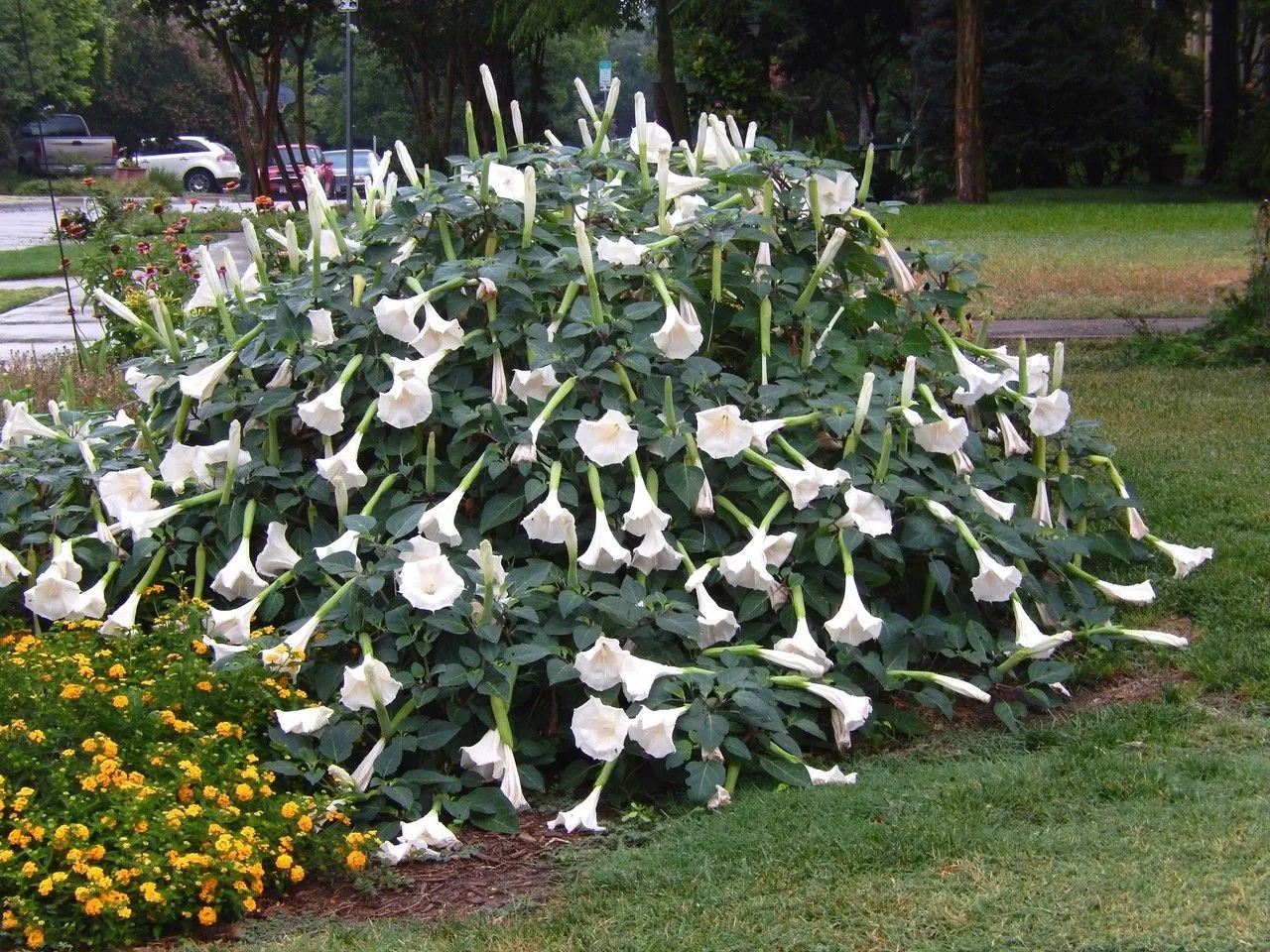
Author: Regel
Bibliography: Gartenflora 8: t. 260 (1859)
Year: 1859
Status: accepted
Rank: species
Genus: Datura
Vegetable: False
Observations: SW. & SC. U.S.A. to N. Mexico
The Hairy Thorn-Apple, scientifically known as Datura wrightii, is a captivating and noteworthy plant belonging to the Solanaceae family. This perennial plant, native to the southwestern and south-central regions of the United States extending into northern Mexico, is recognized for its striking beauty and distinct characteristics.
The Hairy Thorn-Apple is famed for its large, trumpet-shaped flowers that bloom predominantly at night. These blooms, typically white or pale lavender, emit a pleasant fragrance attracting nocturnal pollinators such as moths. The flowers are borne on stout, erect stems and are notably large, often reaching lengths of up to 20 centimeters. Adding to its charm, the plant’s leaves are ovate, dark green, and covered with fine hairs, giving the plant its “hairy” moniker.
Despite its enticing visual appeal, Datura wrightii is a plant that commands respect and caution. It contains potent alkaloids that can be highly toxic if ingested. Historically, various indigenous cultures have revered it for its medicinal and psychoactive properties, using it in rituals and traditional medicine under controlled conditions.
The plant thrives in dry, arid environments and is commonly found in disturbed soils such as those along roadsides, fields, and desert landscapes. It’s well-adapted to withstand the challenging conditions of its native habitats, showcasing resilience and adaptability.
Regel first documented this intriguing species in the notable horticultural publication “Gartenflora” in 1859. His meticulous work contributed significantly to the botanical understanding and classification of this intriguing species, providing valuable insights that continue to aid botanists and horticulturists in the study of Datura wrightii and its relatives within the Solanaceae family.
In cultivation, the Hairy Thorn-Apple is prized for its impressive stature and ornamental value, though growers must handle it with care due to its toxic properties. Its dramatic foliage and show-stopping flowers make it a striking addition to xeriscape gardens and themed plantings, where it can be admired from a safe distance.
In conclusion, Datura wrightii, or the Hairy Thorn-Apple, is a plant of profound beauty and intrigue. Its historical significance, ecological adaptability, and imposing presence make it a subject of continual fascination in botanical circles. However, its toxic nature serves as a reminder of the delicate balance between admiration and caution in the natural world.
Deu: wright-stechapfel
Eng: hairy thorn-apple, hoary thorn-apple, recurved thorn-apple, sacred datura, sacred thorn-apple, sacred thornapple
Swe: indianspikklubba
En: Hairy thorn-apple, Hoary thorn-apple, Sacred thorn-apple, Recurved thorn-apple, Sacred datura, Sacred thornapple
De: Wright-Stechapfel
Sv: Indianspikklubba
Taken Sep 17, 2019 by joselu_4 (cc-by-sa)
Taken Sep 2, 2020 by Ronald Ernst (cc-by-sa)
Taken Jul 20, 2018 by Mariam Martin (cc-by-sa)
Taken Sep 17, 2020 by Mihalachi Razvan (cc-by-sa)
Taken Feb 11, 2018 by Harrison Cannon (cc-by-sa)
Taken Nov 21, 2019 by André Hyvrier (cc-by-sa)
Taken Aug 6, 2018 by Luca Pardi (cc-by-sa)
Taken Sep 24, 2020 by Lugifa Lugifa (cc-by-sa)
Taken Sep 24, 2020 by Lugifa Lugifa (cc-by-sa)
Taken Mar 13, 2020 by Dub D (cc-by-sa)
Taken Nov 8, 2022 by Nicolò Fico (cc-by-sa)
Taken Sep 29, 2019 by cavender27 (cc-by-sa)
Taken Nov 15, 2021 by Alsanabani Jamal (cc-by-sa)
Taken Jul 31, 2018 by Anna Molina (cc-by-sa)
Taken Sep 2, 2020 by Ronald Ernst (cc-by-sa)
Taken Sep 20, 2018 by angela (cc-by-sa)
Taken May 19, 2019 by Karim (cc-by-sa)
Taken Jan 1, 1900 by EOL − John Hilty (cc-by-nc)
Taken May 21, 2022 by Cameron MacFarlane (cc-by-sa)
Taken Jul 22, 2017 by Ruben Gonzo (cc-by-sa)
Taken Apr 8, 2016 by EOL − Neil Frakes (cc-by-nc)
Taken Sep 4, 2022 by Prieta Javier (cc-by-sa)
Taken Oct 18, 2019 by Ramon Martorell Martorell (cc-by-sa)
Taken Jun 13, 2020 by gonzalez oscar (cc-by-sa)
Taken Oct 9, 2015 by EOL − Bob O’Kennon (cc-by-nc)
Taken Jun 3, 2021 by Arsham Hekmat (cc-by-sa)
Taken Sep 15, 2003 by Photoflora – Jean-Luc TASSET (©)
Taken Sep 30, 2010 by Tela Botanica − Alain MAURIC (cc-by-sa)
Taken Jun 28, 2011 by Tela Botanica − Bertrand BUI (cc-by-sa)
Taken Sep 30, 2010 by Tela Botanica − Alain MAURIC (cc-by-sa)
© copyright of the Board of Trustees of the Royal Botanic Gardens, Kew.
© copyright of the Board of Trustees of the Royal Botanic Gardens, Kew.
Growth habit: Forb/herb, Subshrub
Family: Myrtaceae Author: (F.Muell.) K.D.Hill & L.A.S.Johnson Bibliography: Telopea 6: 402 (1995) Year: 1995 Status:…
Family: Rubiaceae Author: Pierre ex A.Froehner Bibliography: Notizbl. Bot. Gart. Berlin-Dahlem 1: 237 (1897) Year:…
Family: Sapindaceae Author: Koidz. Bibliography: J. Coll. Sci. Imp. Univ. Tokyo 32(1): 38 (1911) Year:…
Family: Asteraceae Author: A.Gray Bibliography: Pacif. Railr. Rep.: 107 (1857) Year: 1857 Status: accepted Rank:…
Family: Fabaceae Author: Medik. Bibliography: Vorles. Churpfälz. Phys.-Ökon. Ges. 2: 398 (1787) Year: 1787 Status:…
Family: Aspleniaceae Author: (Cav.) Alston Bibliography: Bull. Misc. Inform. Kew 1932: 309 (1932) Year: 1932…